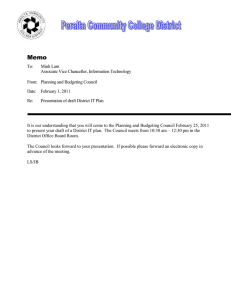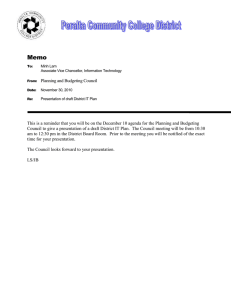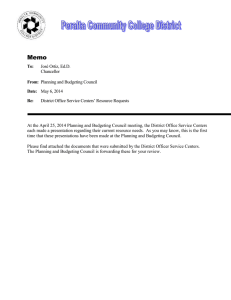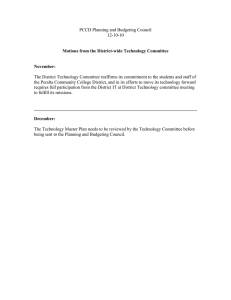David Cababaro Bueno and Rafael D. Mora 10th MANILA International Conference on ASSHIS-17 Dec 17-18 2017
advertisement
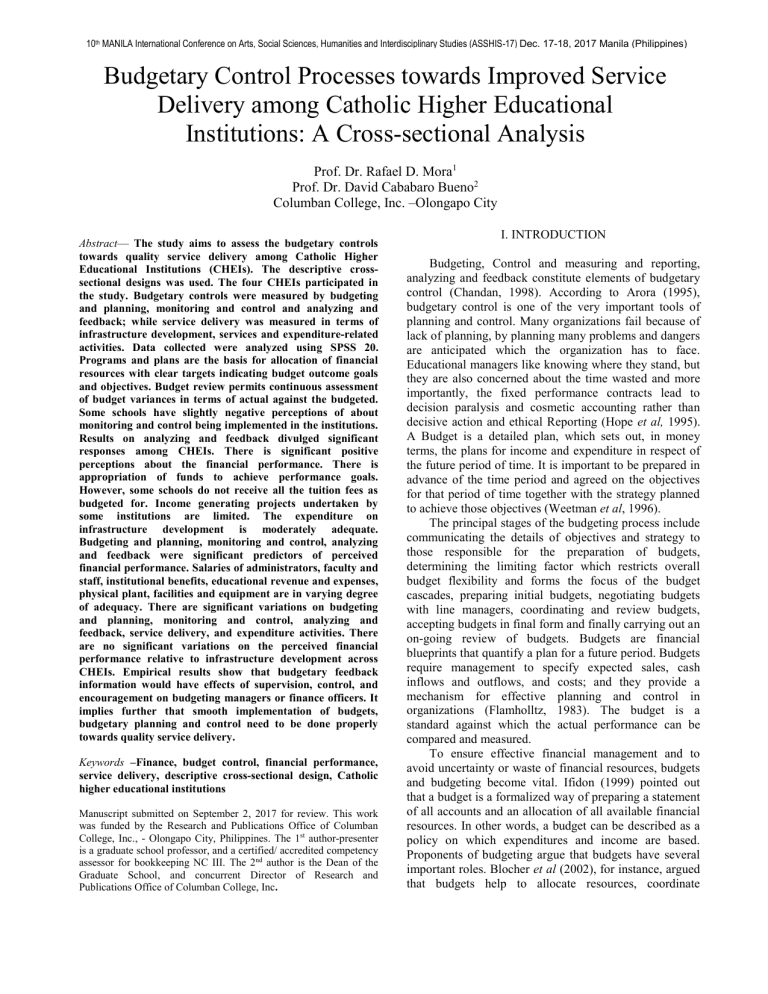
10th MANILA International Conference on Arts, Social Sciences, Humanities and Interdisciplinary Studies (ASSHIS-17) Dec. 17-18, 2017 Manila (Philippines) Budgetary Control Processes towards Improved Service Delivery among Catholic Higher Educational Institutions: A Cross-sectional Analysis Prof. Dr. Rafael D. Mora1 Prof. Dr. David Cababaro Bueno2 Columban College, Inc. –Olongapo City Abstract— The study aims to assess the budgetary controls towards quality service delivery among Catholic Higher Educational Institutions (CHEIs). The descriptive crosssectional designs was used. The four CHEIs participated in the study. Budgetary controls were measured by budgeting and planning, monitoring and control and analyzing and feedback; while service delivery was measured in terms of infrastructure development, services and expenditure-related activities. Data collected were analyzed using SPSS 20. Programs and plans are the basis for allocation of financial resources with clear targets indicating budget outcome goals and objectives. Budget review permits continuous assessment of budget variances in terms of actual against the budgeted. Some schools have slightly negative perceptions of about monitoring and control being implemented in the institutions. Results on analyzing and feedback divulged significant responses among CHEIs. There is significant positive perceptions about the financial performance. There is appropriation of funds to achieve performance goals. However, some schools do not receive all the tuition fees as budgeted for. Income generating projects undertaken by some institutions are limited. The expenditure on infrastructure development is moderately adequate. Budgeting and planning, monitoring and control, analyzing and feedback were significant predictors of perceived financial performance. Salaries of administrators, faculty and staff, institutional benefits, educational revenue and expenses, physical plant, facilities and equipment are in varying degree of adequacy. There are significant variations on budgeting and planning, monitoring and control, analyzing and feedback, service delivery, and expenditure activities. There are no significant variations on the perceived financial performance relative to infrastructure development across CHEIs. Empirical results show that budgetary feedback information would have effects of supervision, control, and encouragement on budgeting managers or finance officers. It implies further that smooth implementation of budgets, budgetary planning and control need to be done properly towards quality service delivery. Keywords –Finance, budget control, financial performance, service delivery, descriptive cross-sectional design, Catholic higher educational institutions Manuscript submitted on September 2, 2017 for review. This work was funded by the Research and Publications Office of Columban College, Inc., - Olongapo City, Philippines. The 1st author-presenter is a graduate school professor, and a certified/ accredited competency assessor for bookkeeping NC III. The 2nd author is the Dean of the Graduate School, and concurrent Director of Research and Publications Office of Columban College, Inc. I. INTRODUCTION Budgeting, Control and measuring and reporting, analyzing and feedback constitute elements of budgetary control (Chandan, 1998). According to Arora (1995), budgetary control is one of the very important tools of planning and control. Many organizations fail because of lack of planning, by planning many problems and dangers are anticipated which the organization has to face. Educational managers like knowing where they stand, but they are also concerned about the time wasted and more importantly, the fixed performance contracts lead to decision paralysis and cosmetic accounting rather than decisive action and ethical Reporting (Hope et al, 1995). A Budget is a detailed plan, which sets out, in money terms, the plans for income and expenditure in respect of the future period of time. It is important to be prepared in advance of the time period and agreed on the objectives for that period of time together with the strategy planned to achieve those objectives (Weetman et al, 1996). The principal stages of the budgeting process include communicating the details of objectives and strategy to those responsible for the preparation of budgets, determining the limiting factor which restricts overall budget flexibility and forms the focus of the budget cascades, preparing initial budgets, negotiating budgets with line managers, coordinating and review budgets, accepting budgets in final form and finally carrying out an on-going review of budgets. Budgets are financial blueprints that quantify a plan for a future period. Budgets require management to specify expected sales, cash inflows and outflows, and costs; and they provide a mechanism for effective planning and control in organizations (Flamholltz, 1983). The budget is a standard against which the actual performance can be compared and measured. To ensure effective financial management and to avoid uncertainty or waste of financial resources, budgets and budgeting become vital. Ifidon (1999) pointed out that a budget is a formalized way of preparing a statement of all accounts and an allocation of all available financial resources. In other words, a budget can be described as a policy on which expenditures and income are based. Proponents of budgeting argue that budgets have several important roles. Blocher et al (2002), for instance, argued that budgets help to allocate resources, coordinate operations and provide a means for performance measurement. Hilton et al (2002) agreed with this view and claim that the budget is the most widely used technique for planning and control purposes. Clarke and Toal (1999) too, were of the opinion that budgets are still essential and can, for example, be incorporated as part of the financial component of the balanced scorecard. Meanwhile, critics of budgets claimed that budgets are no longer adequate and are “fundamentally flawed” as planning and control mechanism in today’s complex and highly uncertain environment (McNally, 2002). Moreover, Stewart (1990) claimed that experts criticized budgets as being ineffective. According to him, “Budgets control the wrong things, like headcount, and miss the right ones, such as quality, customer service and even profits”. This has led to an alternative to budgeting known as “Beyond budgeting” to modernize the budgeting process (Fraser and de Waal, 2001). Thus, the budgeting process may be more important as a manifestation of the political struggle than as an item of financial planning (Weetman et al, 1996). Among the key components of the budgeting process and which in turn affect performance include staff participation and the feedback and control mechanism. The management accounting literature advocated participative budgeting as it provides managers with a sense of belonging and increases the possibility that they will make greater attempts to achieve the organizational budgetary goals. Prior studies on the relationship between budgeting participation and performance have obtained mixed results. Stedry (1990) and Cherrington and Cherrington (1993) found that a participative budgeting approach has a negative impact on performance. In contrast Merchant (1991), Brownell (1992) and Covaleski et al (2003) found a positive relationship between budget participation and performance. The more recent literature, however, appears to advocate a participative approach as it can be more effective and people may be more inclined to attempt to achieve budgetary goals if they have been consulted in the budget-setting exercise (Hilton et al, 2000). Fisher et al, (2000) and Chow et al (1988) suggested that participation provided opportunities for managers to create budgeting slack, whereas low participation restricts such opportunities. Budgetary slack is defined as the amount by which managers intentionally build excess requirement for resources into the budget or knowingly understate productive capacity (Young, 1985). Research has however found that the relationship between participation and slack is inconsistent. Participative budgeting might have a different impact on lower level managers than on higher-level managers. Feelings of lack of control in work situations were more prevalent at lower organizational levels (Covaleski and Dirsmith, 1986, Semler, 1989). Higher-level managers can exercise more control over their work situations, because of their position in the hierarchy, than lower level manager. Frucot and Shearon (1991), using the locus of control as a moderating factor, found that hierarchical levels affected the impact of budgetary participation of Mexican managers. Other Studies, however, lead one to conclude that, although participative management is seen as being rather “politically correct” currently, it may be that its value is situation-specific: there may be some organizations in which it is not necessarily a major motivational force. According to Cherrington and Cherington’s (1973) study found that the “top down” imposition of budget targets led to higher performance amongst the recipients as opposed to those managers who, more or less set their own targets. Also, contrary to current popular belief, the setting of budget targets and budgetary control does not always lead to autocratic managerial behavior (Decoster and Fertakis, 1968). Managers can be motivated to respond to such pressures by exercising their authority in an inclusive, supportive, democratic, participatory way. Tertiary institutions draw budgets annually. However, there are inconsistencies in the budgetary implementation, hence failure to stick to the drawn budgets. This has resulted in failure to meet budgetary obligations in some of these institutions. There have been delays in staff salaries, payment of suppliers and school activities have stalled because of lack of funds, though these activities were budgeted for. It is imperative, therefore, to investigate these inconsistencies and failures in financial performance towards service delivery among CHEIs. II. OBJECTIVE OF THE STUDY The study seeks to assess the budgetary controls and perceived service delivery of CHEIs in the Diocese of Iba. It aims to analyze the: (1) budgetary control processes; (2) perceived financial performance among higher educational institutions; (3) variations in the budgetary controls and perceived financial performance among institutions; and (4) implications of the findings towards the improvement of budgetary controls and financial performance of these institutions. III. METHODOLOGY The researchers used the descriptive cross-sectional design of research. The study covered the four CHEIs in the Diocese of Iba, Zambales, and considered the administrative officer/ finance officer/ VP-Administration and Finance and some academic heads as participants. They were chosen purposively since they were more knowledgeable and capable regarding the present status of their schools, particularly in analyzing the budgetary controls and perceived financial performance and other related factors. The primary data were collected using standardized closed structured questionnaires which were adopted by the researchers. These questionnaires were self-administered among the respondents in order to collect the completed responses within a short time possible. Budgetary Control was measured by Budgeting and Planning, Monitoring and Control and Analyzing and Feedback which was subjected to a 5 point anchored Likert scale for Mwabilu et al., 2004. Perceived financial performance was measured by Infrastructure Development, Service Delivery and expenditure related activities which were subjected to a modified version of multi-item, five-Likert scale developed by Melkers and Willoughby (2002) to suit the study at hand. The actual financial performance was measured in terms of the salary range of administrators, instructor and staff. This was adopted for the study of Reyes (2013). Permission was obtained from the presidents/ directors of institutions through the head-commission on higher education. The participants were informed of the nature and procedures of the study and the confidentiality was observed. The distribution and retrieval of the instrument were personally done by the researchers. The data collected were classified, coded and analyzed using SPSS 20.0. IV. RESULTS AND DISCUSSION Budgetary Controls. The CHEIs strongly agree that they always prepare budgets in preparation for the opening of the school year as shown by the computed mean of 5.00. Likewise, the internal stakeholders include department and academic heads are involved in the budget setting process as evidenced by the computed mean of 5.00. Performance indicators are included in the budgets (4.67), and resource re-allocation is based on the indicators (4.43). Moreover, budgets take into account the three year development plan (4.38), and the line managers are involved in the budgeting process (4.62). According to them, they always present the budget to the members of the BOT for approval (4.75), who are knowledgeable of the budgeting process (4.75). The budgets are based on the needs identified by the sections/ departments (4.75), and they have clear result targets in the budget (4.75) with appropriate resources (4.62). Furthermore, they believed that planning helps to manage the programs of the institution (4.75). In planning, they discuss goals to be met with the management (4.75), and the program activities are clearly indicated (4.75). They strongly agree that programs and plans are the basis for allocating financial resources and setting priorities for the coming year at budget conference. Moreover, planning of the budget activities is done by the departments (4.37), and the budget priorities are agreed upon in the budget conference (4.37). However, when collectively taken, they simply agree that all the stakeholders to the budget are involved (3.80), and they normally publish the budget after approval (3.45). The overall assessment per CHEI on budgeting and planning are 4.90 (strongly agree) for CHEI A; 4.00 (agree) for CHEI B; 4.80 (strongly agree) for CHEI C; and 4.70 (strongly agree) for CHEI D. Thus, the overall assessment among CHEIs is 4.61, which means strongly agree. This means clear result targets are set indicating budget outcome goals and objectives being linked to programs. Building of consensus is useful by way of discussing the goals to be met with all stakeholders. Hilton et al, (2000), agreed with this view that budgeting is the most widely used technique for planning and control purposes. Secondly, budget monitoring in terms of budget reviews is important as it paves way for budget adjustments. The agreement of budget priorities is not done in budget conference and neither are budget reviews which are useful in determining the budget variances done. Besides, budgets are initiated in two formats: imposed budget and participative budget (Brownell and McInnes, 1986; Poon et al., 2001). Top-down imposed budget tends to cause members’ complaints and abrasive reaction, while bottom-up participative budget tends to gain members’ cooperation (Brownell and McInnes, 1986). The latter is considered most motivating by scholars but requires members’ understanding and accepting organizations’ strategies in the initiating process (Poon et al., 2001). Budgeting targets solely set by top management might be too difficult or too loose. On the contrary, if solely set by subordinates, budgetary slacks could occur and the organization could get disoriented (Chaney et al., 2002). Thus, ideally, budgeting control system should be established by all members or stakeholders, top management proposes the visions of organization development, whereas subordinates provide information on daily operation details (Chong and Johnson, 2007). Hence, the implementation approach of budgets could also affect members’ budgetary perceptions. The participant strongly agree that the funding of budget programs is based on institutions approved budget (4.75); and the BOT normally checks on the progress as planned (4.37). It means, the performance is always communicated (4.50). Thus, the perceived level of budget monitoring and control in my institution is excellent and adequate (4.25). Moreover, there is clear tracking of program results among the institutions (4.25) by using books of accounts. However, they agree that they often receive guidelines from the Department of Finance/ CHED on the budget process (3.87); and the budgeting process is expedited by use of budget officers (3.67); often hold budget conferences to review performance (3.80); and the costed activities are always reviewed by the executive committee (4.05). When considered per CHEI, the computed means are 4.94 (strongly agree) for CHEI A; 3.20 (agree) for CHEI B; 4.73 (strongly agree) for CHEI C; and 3.90 (agree) to CHEI D. Thus, the overall assessment is 4.19 (agree). It appears that the participants are aware that financial control and monitoring helps to ensure efficient and cost-effective program implementation within a system of accountability, coupled with a constant program implementation for better budget implementation in accordance with agreed plans. The process shows the degree of how a superior requires budgetary gap analysis and a bases performance appraisal on budgeting information (Kenis, 2009). The nature of budgetary evaluation lies in execution force in controlling budge, in order to deal with exception management (Brownell, 2011). On the other hand, the result of budgeting execution is normally done in order to integrate with the incentive compensation system to perform the function of encouraging employees (Bonner and Sprinkle, 2012). When taken collectively per item, the participants strongly agree that budget performance reports are prepared regularly in each institution (4.50); budget deviations are reported to the budget committee/top management (4.50); deviations from the budget targets are frequently reported (4.42); and the management always takes timely corrective actions when adverse variances are reported (4.37). However, they simply agree that there is clear reporting of program results; Follow up of deviations is done; financial performance is communicated frequently in meetings; deviations from the expected and the actual /reported results are common; budgets are always balanced; and analysis of deviations is necessary among institutions. Thus, the overall assessment is 4.17 (agree). Thus, reports may be issued with sufficient frequency to facilitate adjustments to offtarget operations. When members of an organization do not know the results of their efforts, they have no indication of success or failure and no incentive for higher performance. Although, Henderson (2007) mentioned the importance of budgetary feedback and control for improving managerial performance, they did not investigate how the disclosure of such information affects other managerial behavior. Sometimes, top management instructs its unit heads to work towards budget targets but does not want such managers to know the rationale behind their decisions. Consequently, these department heads can lose direction and uncertainties can be created. Managers can solve problems only by creating budgetary slack, and they might use the slack to cover the variance figures. As a result, wastage can be created (Lukka, 1988). Financial Performance. The participants strongly agree that the staff receives their salaries and allowances on time (5.00); the funds for food and its preparation are always released on time (4.75); they are always paid topup in addition to the basic monthly salary (4.50); suppliers are always paid on time (4.25); and the expenditure on students’ food during school-related activities and its preparation are genuine (4.75).On the other hand, the respondents only agree on the adequacy of expenditure on infrastructure development against total expenditure; achieving the targets within the budgeted period; and the timeliness of disbursement of finances upon requisition. Thus, the overall assessment when analyzed per school, respondents from CHEI A gave a rating of 4.96 (strongly agree); 4.12 (agree) for CHEI B; 4.37 (strongly agree) for CHEI C; and 4.12 (agree) for CHEI D. Thus, the overall assessment is 4.39 (strongly agree). Perceived budget performance refers to the perceptions or feelings of participants in respect to how well or badly the objectives of the organization are achieved through budget performance, and this would be in respect to the revenue performance, expenditure performance and value for money performance. When the assessment is considered per school, the perceived financial performance relative to service delivery is 5.00 (strongly agree) for school A; 3.50 (agree) for school B; 3.87 (agree) for school C; and 3.62 (agree) to school D. Thus, the overall computed value is 4.00 (agree). Various institutions are providing financial assistance through scholarship grants or through provision of educational equipment and other facilities to include the Institutional Development Assistance for Accreditation (IDAA). Non-profit organizations must deal with the complexities of building; maintaining and managing performance based budgeting systems. “The non-profit organizations start with the performance of their Mission” (Druker, 1992), and the level of service delivery is high, since most of the requirements are taken care of in the budget as a result also infrastructure development is taking root. The CHEIs strongly agree that all the budgeted activities are implemented as planned for (4.25); the expenditure on instructional materials is adequate (4.42); and the expenditure on students’ welfare is adequate every semester (4.50). Furthermore, they agree that their income generating projects undertaken by my institution; the expenditure on infrastructure development is adequate; the expenditure on ICT meets the demands of the changing environment, which are part of the plan; and the budget expenditure on maintenance and repairs is adequate. According to Gonahasa (1994), a proper budget should show all the activities to include income generating projects, instructional materials, infrastructure development, ICT requirements, students welfare and development as well as expenditures on maintenance and repairs intended for the coming year, thus pointing to a budgeting paradigm, which is based on the establishment of financial performance measures which measures act as a gauge to most important issues in the situation and how well it will reflect good financial performance. However, most plans do not exactly and clearly show how funding would be appropriated to achieve performance goals. It is actually identifying the objectives without identifying the means for achieving it. Variations in the Budgetary Controls and Financial Performance. The null hypothesis stating that “there are no significant variations in the budgetary controls across HEIs” is rejected on the areas of budgeting and planning, monitoring and control, analyzing and feedback because the computed F values are greater than the critical F values. Thus, there are significant variations in the budgetary controls across CHEIs. On the other hand, the null hypothesis stating that “there are no significant variations in the perceived financial performance across HEIs” is rejected on the areas of service delivery, and expenditure activities because the computed F values are greater than the critical F values. However, on the area of infrastructure development, the null hypothesis is accepted. Thus, significant variations on the perceived financial performance are found relative to service delivery and expenditure activities; but insignificant variations are found on infrastructure development across CHEIs. Implications of the Findings. Empirical results show that department heads and other stakeholders are taking part in budget planning indicating that the empowerment intensity to budget is high. This would further enhance positive and agreeable attitude of the budgetary participation, and would have a positive effect on budgetary motivation. However, due to budget planning principles of the institutions is proposed by department heads, and then distributed in terms of department performance or employee/ staff number, thus, the intensity of budgetary participation is not relevant to budgetary slack. In other words, it is not that a department head who highly participates in budget planning would, therefore, propose a slacker budget, but he should do it according to overall performance and department activities. In consequence, the result suggests that budget/ finance officer should take the consistency between organizational objectives/ goals and department strategic objectives/ goals as guidelines of budget planning, rather than the merely budget achievement ratio of an individual department. Only when the budget officer has positive budgetary attitude, then he is capable of achieving budgeting functions of financial management, cost control, resource planning, and performance measurement. Therefore, the higher usefulness and relevance the budget has, the more it helps the institution to accurately assess whether each department fulfill strategic objectives towards quality service delivery. V. CONCLUSIONS AND RECOMMENDATIONS For proper budgetary control to be done, programs and plans are the basis for allocation of financial resources. Budget reviews is important as it paves way for budget adjustments. It is important for the financial performance to be communicated to the stakeholders by the budget officers. Feedback is an important aspect in budgeting that attains quality and standards in planning, control and leadership as revealed by the CHEIs. There was a high level of financial performance. The CHEIs show all the activities intended for the coming year. Institutional plans clearly show how funding would be appropriated to achieve performance goals. However, some schools do not receive all the tuition fees as budgeted for. The institutions are faced with challenges to performance budget implementation among which, lack of credible and useful performance information, difficulty in achieving consensus on goals and measures because of low levels of participation is the major drawbacks. Income generating projects undertaken by some institutions are limited. The expenditure on infrastructure development is moderately adequate. The findings indicate that budgetary controls are significant predictors of financial performance. There are significant variations on the perceived financial performance across schools. There are no significant variations on the perceived financial performance relative to infrastructure development across schools. The administration of CHEIs should promote budgetary controls through stakeholders, involvement. There is a need for a sensitization drive through training, workshops, seminars and meetings on the values of implementation of budgeting and planning, monitoring and control and analyzing and feedback. The BOT should focus attention on important points in the implementation process of the budgetary controls and adequately monitor the institutions financial performance vis-à-vis budget formulation and implementation. The CHEIs need to adopt the bottom – top approach. The performance reports should be made quarterly. The level of feedback and level of participation of stakeholders needs to be upheld and strengthened in order to have an effective and efficient budgeting process. It should be mandatory that budgeting process for the different units /departments are conducted. ACKNOWLEDGMENT The authors acknowledge the assistance of the research staff, for the distribution and retrieval of surveys, and currently enrolled graduate students for the data gathering; and Columban College, Inc. for funding the study. REFERENCES Alesina, A. & Perotti, R. (1996). “Reducing Budget Deficits”, Swedish Economic Policy Review, Vol. 3, No. 1 Amaratunga, (2001). The role of Performance Measurement in Manufacturing Excellence, 27th Annual BPCIS Conference Birmingham, UK. Andre’ A .de Waal (2005); Insights from practice, is your organization ready for beyond budgeting? Measuring Business excellence Vol 9 No: 2 Andy Neely, Mike Bourne and Chris Adams (2003) Better Budgeting or beyond Budgeting? Measuring Business Excellence Vol.7 No: 2 Argyris, C. (1952); The impacts of Budgets on People, Controllership Foundation, Cornell University, Ithaca, NY Arora, M.N. (1995). Cost Accounting, Principles and Practice. (4th ed.). Vikas Publishing Becker, S.W. and Green, D. (1962), “Budgeting and employee behavior” Journal of Business, Vol.35 No: 4 October Benlo, H. (1990). Business Budgeting and Control: New York, the Ronald Press. Bestebruer and Henk (2003). New Public Budgeting in the Netherlands; Local and National Efforts: a critical appraisal, Paper for the 2003 annual EGPA conference in Oeiras, Portugal. Bhatia, H.I (1996). Public Finance. (19th ed.). Vikas Publishing House, New Delhi, India. Blocher, (2002). Cost Management: A Strategic Emphasis. (2nd ed.). McGraw-Hill International, New York, NY. Brewer, A. (1993). Managing for Employee Commitment, Longman, Sydney. Briers, M and Hirst, M (1990), The Role of budgetary information in performance evaluation” Accounting Organizations and society, Vol.15 No: 4 Briston, R.J. (1981). Introduction to Accounting and Finance, Macmillan, London. Brownell, P. (1982), “The role of accounting data in Performance evaluation, Budgetary participation, and organizational effectiveness, Journal of Accounting Research, Spring Carr, J. Joseph, (2000). Requirements Engineering and Management: The Key to Designing Quality Complex Systems: The TQM Magazine Volume 12 No. 6 Casio, W.F. (1998). Applied Psychology in Human Resource Management, (5th ed.). Prentice Hall International, UK. Chandan, J.C. (1995). Management Theory and Practice. Vikas Publishing House, New Delhi. Clarke and Toal (1999). “Performance Measurement in Small Firms in Ireland” Irish Accounting Review, 6 Colin Drury (1996); Management and Cost Accounting, 4th Edition Cook (1968). “The Effects of Frequency of Feedback on Attitudes and Performance: Empirical Research in Accounting, Selected Studies”. Journal of Accounting Research Supplement. Volume 6 Cumby, J.F. & Conrod, B. (2001). A Positive Corporate IQ is the Sole of Retention. Hotel and Motel Management. Daniel Emojorho (2004); The Bottom Line: Managing Library Finances Vol 17 No: 3 Dannilo, A.S. (2002). Accountability to the Poor: Experience in Civic Engagement in Public Expenditure. Action Learning Program, World Bank. Eccles, R. (1991) “The Performance Measurement Manifesto”. Harvard Business Review, January-February Emmanuel, C.R. & Otley, D.T (1985). Budgetary Planning and Control. Accounting for Management Control. Berkshire, Van Nostrand Reihold (UK) Co. LTD. Friedman, M (1997), “A guide to developing and using performance measures in result based budgeting” Fiscal Policy studies Institute, Baltimore, Maryland, May Glaser, Mark and Robert Denhardt.2000.”Local Government performance through the Eyes of Citizens” Journal of Public Budgeting, Accounting and Financial Management Glautier, (1997). Accounting Theory and Practice. (6th ed.). Pitman Publishing, London. Gonahasa, (1994). Report of the School Charges Review Taskforce. Entebbe Government Printers, Kampala. Guthrie, J.F. & Petty, T. (2001). “Evidence of Australian Organizations Intellectual Capital Statements and Management Practices”, 4th World Class on Intellectual Capital, January 17-19 Ham, Hon, Ontario. Hayes, R.H. & Abernathy, W.J, (1980), “Managing our way to Economic Decline”, Harvard Business Review, No. July/August. Hilton, (2000). Cost Management: Strategies for Business Decisions. McGraw-Hill International, New York, NY. Howard Frank (2002), Teaching Performance Measurement in a core MPA budgeting class. Journal of Public Affairs Education Vol.2 Huselid, M.A (1995). The Impact of Human Resource Practices on Turnover, Productivity and Corporate Financial performance. Academy of Management Journal. Jackie Brander Brown and Helen Atkinson (2001); Budgeting in the information age: a fresh approach, International Journal of contemporary Hospitality management. Johnson and Kaplan, (1987). Relevance Lost: The Rise and fall of Management Accounting, Harvard Business School Press, Boston MA. Kaplan, (1988, 1990). “One Cost System is not enough”, Harvard Business Review, No. January/February. “Contribution Margin Analysis: no longer Relevant” Journal of Management Accounting Research Kelly, (2003). Vice President, Marketing and Sales AUL, interview, November. Kerr, T. (1979). Consumer Perception of Price Quality and Value: a Measured Model and Synthesis of Evidence. Journal of Financial Management Vol.52 July. Kreitner, R. (1989). Management, 4th Edition, Houghton Mifflin Cony, New Jersey, USA. Krejecie, B and Morgan R (2002), Generalized Scientific guidelines for sample size decisions. London, Pitman Publishing, Long Acre 5th Edition. Kydland, F. & Prescott, E. (1977). Rules Versus Discretion: The Inconsistency of Optimal Plans: Journal of Political Economy. Lucy, T. (1996). Costing. (5th ed.). D.P. Publications, London. Mathis, (1996). Management Concepts and Effective Practice. (3rd ed.). West Publishing Co., Los Angels. Mc Nally (2002). “The Annual Budgeting Process”, Accountancy Ireland, Volume 34, No.1. McGill (2001). Government Budgeting and Expenditure Controls, Theory and Practice: International Monetary Fund, Washington D.C. 1983, IMF. McGill, R (1984), Evaluating organizational Performance in public administration”, Public Administration Bulletin, No.46 Melkers and Willoughby (2002). Evolving Performance Measurement in Local Governments: Presented at 2002 Meeting of the ABFM, Kansas City, MO. Millichamp, A.H. (1990). Auditing: An Introduction Manual for Accounting Students, D.P. Publications, Shepherds Bush Green, London. Mordi (2000). "Budgeting and Financial Management", the Delta Bureaucrat: A Quarterly Magazine. Mwabilu, (2004). Outcome Budgeting: Assessment of its Goals and Objectives across Government Levels Nanni et al., (1990). Strategic Control and Performance Measurement, Journal of Cost Management Nassolo Florence, (1997). The Introduction and Management of Private Programmes Budget in Organizational Development Perceptive. Neely, A. D (1994), Performance measurement system designthird phase, Performance Measurement system Design Workbook Otley, S. (1987). Budget Use and Management Performance. Journal of Accounting Research. Vol. 16 No.1 Parasuraman, A., Zeithml, V.A. & Berry, L.I. (1994). Alternative Scales for Measuring Service Quality: A Comparative Assessment Based on Psychometric and Diagnostic Criteria, Journal of Retailing Parker, C. (2000) Performance Measurement, Work Study, Vol 49 No: 2 Pauline Weetman (1996); Financial and Management Accounting, An Introduction, Heriot-Watt University. Pettigrew, I. (1992). Moving beyond Lean and Mean, Journal of Business Strategy Vol. 4 Phyrr (1970). Zero Based Budgeting. Harvard Business Review Vol.4 Pierce and O’Dea (1998). “An Empirical Study of Management Accounting Practices in Ireland”. Irish Accounting Review, Volume 5. No.2 Prendergast, P. (2000). “Budgets Hit Back”, Management Accounting Rasbery, P.W. & Lormnie, L.F. (1986). Effective Management Communications, Boston, PWS Publishing Company. Reyes, Amelia Cecilia S. (2013). Status of CESDI: Basis for the Proposed Transition Guidelines in the Implementation of Senior High School Program. Dissertation, Columban College, Inc., Olongapo City Ronald, McGill (2001); Performance Budgeting, International Journal of Public sector Management Vol.14 No: 5 Russell Abratt, Maria Beffon and John Ford (1994) Marketing Intelligence and Planning Vol.12 No: 1 Sallis, E. (1996). Total Quality Management in Education, Kogan Page, London. Scarborough et al., (1991), “Japanese Management Accounting Practices and the Effects of Assembly and Process Automation,” Management Accounting Research, Volume 2 Scott, W.R. (1987). Information Processing: Creating Organizations. Sebbi, (1994) and Lewis, (1996). “Budget Performance in Ugandans Local Authorities: A Case Study of Rakai DistricAdministration. 1988-93. a Dissertation presented to UMI in partial Fulfillment for the Award of the Diploma in Financial Management of UMI”. Sekaran Uma. (2000). Research Methods for Business. (3rdedition). Hermitage Publishing Services, Printed and bound by Malloy Lithographic Inc, United States of America. Selznick, P. (1988). Foundations of the Theory of Organizations, American Sociology Review, 13th February Stannack, P. (1996). Strategic Control and Performance Measurement, Journal of Cost Management Stewart, T.A. (1990). “Why Budgets are bad for Business” Fortune, No.4, June Stoner, J.A. (1996). Management: New York, Prentice Hall. Wildavsky, A (1975), Budgeting-A comparative Theory of Budgeting Processes, Little, Brown and Co., Boston. Zimmerman, (2003). Accounting for Decision Making and Control. (4th ed.). McGraw- Hill, New York, NY. Prof. Dr. David Cababaro Bueno is a holder of Doctor of Education, Master of Arts in Science Education, Master in Public Management, Master in Business Administration, and Bachelor of Arts degrees. He is a candidate for graduation leading to the degree of Doctor in Business Administration and currently taking Doctor in Public Management. He is one of the awardees for the Sectoral Engagement grant to conduct research on “Human Resources Skills Comprehensive Development Plan for Region 3 under Commission on Higher Education’s Faculty Development Program for K-12 Transition. He authored and co-authored books in Research and Thesis Writing, Statistics for Research, Practical Quantitative Research, Practical Qualitative Research, Biological Science for College Students, Physical Science for College Students, Human Resource Management, Organization and Management, Curriculum Development, Environmental Science, Research Writing Made Easy for Business and Hospitality Students, Elements of Biological Science, Food Safety and Sanitation, Fundamentals of Physical Science, and Introduction to Human Biology. He is currently the Dean of the Graduate School and concurrent Director of Research and Publications at Columban College, Inc. Dr. Bueno is an active member of various national and international professional organizations, research technical committee and reviewer of various international conferences, statistician, seminar-workshop speaker and multi-awarded research presenter in the ASEAN community. Prof. Dr. Rafael D. Mora is a holder of BSA, MBA and Doctor of Education (Ed.D.) in Educational Administration. He is an accredited assessor of the TESDA certification for Bookkeeping NCIII. Dr. Mora is also currently working as accountant at the Accounting Department of Columban College, Inc., while serving in concurrent position as research staff and graduate school professor handling business administration courses and school finance and management in the doctorate program.

